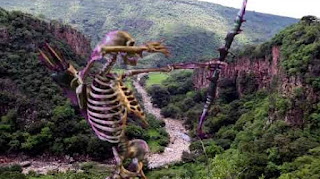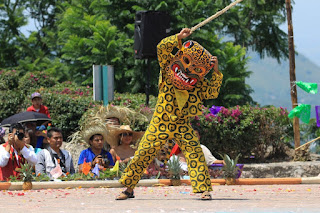Mythologies of the Tecuexes Tribe
The Tecuexe were an Indigenous peoples of Mexico, who lived in the eastern part of present-day Guadalajara. It is believed that the Tecuexe derived from the dispersion of Zacateco groups from La Quemada. Like the Zacatecos, the Tecuexe were a tribe belonging to the generic "Chichimeca" peoples. It is known that they settled next to rivers which they used to their advantage to grow beans and corn. They were also expert artisans, carpenters and musicians. Toribio de Benavente Motolinia wrote "in any place… all know to work a stone, to make a house simple, to twist a cord and a rope, and the other subtle offices that do not require instruments or much art." The Tecuexe were known for their fierceness and cruelty towards their enemy. They were known to be so brave, it is said, that once, when the Mexica (Aztecs) came from Chicomostoc, Zacatecas to take control of Xolotl, (and course on to the lagoon where they found an eagle devouring a serpent) they attacked the settlers of Acatic, Teocaltiche, Mitic, Teocaltitán and Xalostotitlán, but in Tepatitlán, when they encountered the Tecuexe, having heard of their legendary cruelty, the Mexica avoided facing them. The Tecuexes wore dresses with classic tilmatl (tilma) and huipilli, worn with comfortable cactlis and adorned their bodies with necklaces, bracelets, earrings and nose rings that they themselves made. They liked to make their houses in valleys and gorges near rivers, always in a position ready to battle. They also had temples in Teocaltiche, San Miguel el Alto, Jalostotitlán, Teocaltitan de Guadalupe and possibly in Tepatitlán.
The Tecuexes Indians occupied a considerable area of Jalisco north of Guadalajara and western Los Altos, including Mexticacan, Jalostotitlan, Tepatitilan, Yahualica, Juchitlán, and Tonalán. The Tecuexes also occupied the central region near Tequila, Amatltán, Cuquio, and Epatan. The Tecuexes have been studied by Dr. Phil Weigand, who wrote articles on them. They no longer exist as a cultural group. The Tecuexes were one of the many ethnic groups living in West Mexico when the Spaniards arrived in the sixteenth century. This chapter provides an attempt to correlate ethnohistorical and archaeological data, and thereby gain some understanding of this neglected corner of Mesoamerica and deals with the Tecuexes. Relations between Tecuexes and Cocas in the Guadalajara area were peaceful and they may have fought as allies to drive back Tarascans who invaded their province shortly before the Spaniards arrived. The shaft tomb complex is the earliest evidence for humans found so far in the Guadalajara area. In Cuinacuaro the Indians ate human flesh, and the Spaniards found there many remains of roasted Indians. In the Magdalena Basin closely woven reeds were used to manufacture balsas on which the Indians stood to propel themselves around the lagoon by means of a pole or paddle, and many well-made "canoes" are mentioned by the Visitacion.
The Tecuexes (means 'stone terrace') were an ethnic group belonging to the so-called Chichimecas, they lived in the northeast and center of the state of Jalisco, on the large plateau of Alteña (Altos de Jalisco), they were of Nahuatl origin and spoke a language from Uto-Aztec linguistic trunk. They were organized into several independent lordships governed by monarchs belonging to the lineages of the most popular warriors (tlahtoani). Before the arrival of the Spanish there were ten Tecuex lordships and two Tecuex kingdoms. Their territory bordered to the north with the Caxcanes, to the northeast with the Guachichiles, to the east with the Guamares and to the south with the Tarascos. It is believed that this Tecuexe ethical group was formed from Zacateco groups. From their way of life it is known that they lived in areas close to rivers, to take advantage of all the advantages that the rivers offered them, however they built pyramids on top of hills either to defend themselves or as a ceremonial center. The Tecuexes fished, hunted, gathered wild fruits and grew beans and corn. They were skilled in crafts, carpentry, and musical sounds that did not require complex instruments. Tonallan was the largest Tecuexe city, thousands of people lived there. Upon the arrival of the Spanish, this kingdom was ruled by a Cihualpilli Tzapotzinco woman. The Tecuexes were great warriors, when they entered the war they gave a loud and loud cry that frightened their opponents, the sound was so shocking that it seemed like the sky was opening. The Tecuexes warriors had fierce tattoos on their faces, horizontal black bands at eye level. They were also cannibals, after battles the Tecuexes collected the bodies of their enemies who died in battle just to eat them. They had important government centers or chiefdoms like Acatic, which had its own law, language, religion and rules of coexistence. The society formed 3 castes: the priestly one that governed the population such as shamans, priests, healers or healers who were owners of knowledge about plants and rituals; the military in whom the advisory power of the government rested and the possible battles to be faced; and the Popular, where daily activities such as agriculture, pottery, etc. fell. The Tecuexe man used to cover himself with blankets that he threw over his shoulders, joined in several parts and leaving an opening for the head. They used to have feathers in the arches of their rockroses secured by colorful cords dyed in bright colors and decorated with branches of ahuehuete They were a little taller than other tribes, with more cultural traditions, braver and more fearsome. Tecuexe women socially had the same privileges as men: they participated in the town councils, they knew how to use weapons and were called to war if necessary, according to the data they were greatly feared by the Spaniards because their screams were very strident and their echo ran through much of the ravine. They were hardworking and diligent in agricultural work, they were also artists in pottery, in the art of spinning and weaving cotton. The Tecuex settlers danced monorhythmic textures forming circles to the sound of the teponahuaste (teponaztli), a type of very sonorous black stone castanets and a type of bells that they placed on their necks and ankles; Their dance was a constant chase (walk) that staged their most recent struggles. Unlike other indigenous peoples of that time, the Tecuexes did not have great luxuries like those who built large pyramids or who worked with materials such as gold for their clothing. However, they enjoyed an excellent organization that allowed the entire population to enjoy the benefits of his people. There are several archaeological centers that, despite being in deplorable states of conservation, give an idea of the lifestyle that the Tecuexes led before the conquest.


































Comments
Post a Comment